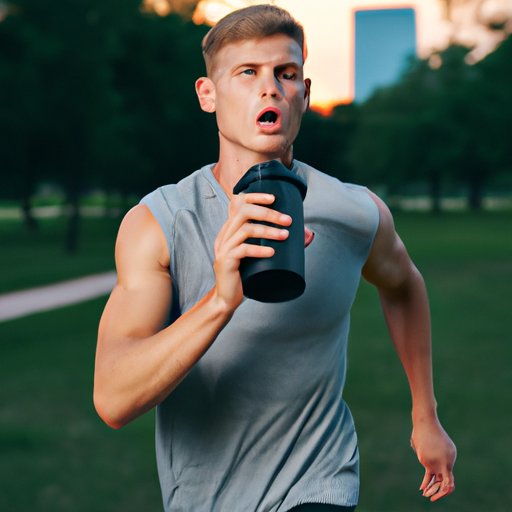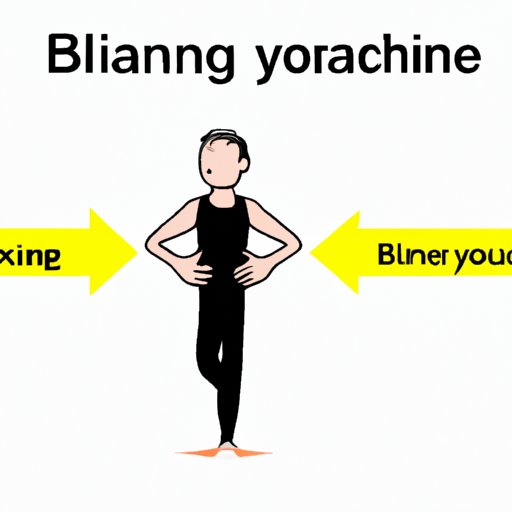
I. Introduction
Running is an excellent way to stay in shape, manage weight, reduce stress and improve mental and physical health. When running, proper breathing technique is critical for stamina, endurance, and overall performance. In this article, we will discuss how breathing affects running performance, the importance of developing proper breathing techniques, and various tips for runners to maximize their breathing efficiency.
II. The Importance of Proper Breathing when Running
Breathing is essential for energy production, and it affects the body’s ability to deliver oxygen to muscles during exercise. Proper breathing technique helps runners deliver more oxygen to their muscles, increasing efficiency, and reducing waste products such as carbon dioxide. When a runner’s breathing is shallow or irregular, they may experience side stitches, cramps, dizziness, or discomfort. Poor breathing technique may also lead to reduced running endurance and slower recovery times. Developing the right breathing habits when running is crucial for optimum results.
III. 5 Breathing Techniques for Runners to Improve Endurance
Breathing and running can be a little tricky to master, but here are some helpful breathing techniques for runners of all levels:
1. Diaphragmatic Breathing
Diaphragmatic breathing involves contracting your diaphragm, allowing your lungs to take in more oxygen. As a runner, you need to learn how to enhance breathing through your nose and breathe out of your mouth. To implement this technique, inhale through your nose deeply and fill your lungs with air, thus expanding your belly and lower ribcage. Then exhale slowly through your mouth for a few seconds, pushing all the air out of your lungs. Try repeating this process for five to ten minutes regularly.
2. 2:2 Breathing
2:2 breathing is commonly used by runners to improve breathing and endurance. This technique involves inhaling and exhaling for two seconds each. For example, inhale for two counts, and exhale for two counts. This method can be modified to other ratios, such as 3:3, 4:4, or 2:1, where inhalation and exhalation can be of different lengths.
3. Cadence Breathing
Cadence breathing synchronizes your breathing with your foot strikes, ensuring your breaths become more efficient and rhythmic. To begin, take one breath for every four steps. As you develop more stamina, try breathing in and out every two or three steps. Continue adjusting your cadence until you find a comfortable rhythm.
4. Interval Breathing
Interval breathing can help runners maintain a steady breathing pattern and avoid shortness of breath. The technique consists of taking a deep breath, breathing out forcibly, then waiting for a few seconds before taking another breath. This technique helps regulate breathing and increases lung capacity.
5. Nasal Breathing
Nasal Breathing is a technique that involves inhaling and exhaling through your nose, making it easier to maintain a steady breathing pattern. This technique also warms and moistens the air before it enters your lungs, reducing the chance of irritation. It’s recommended for those who suffer from exercise-induced asthma.
IV. Breathe Your Way to Better Running: Tips for Beginners
Proper breathing technique takes time and practice, and here are some tips to develop better breathing habits for beginners:
1. Start Slowly
When first starting to run, begin with a slow walking or jogging pace to allow your body to adjust to the stress. Trying to run too fast can make it difficult to maintain steady breathing and lead to exhaustion.
2. Focus on Inhaling
When focusing on breathing, the inhalation stage is the most important. As you exhale, your body will naturally release air, and without proper inhalation, you won’t have sufficient oxygen to keep going. Therefore, make every effort to inhale correctly and deeply.
3. Relax
Relaxation helps improve breathing patterns. Avoid an upright posture, hunching your shoulders, or tensing up your muscles—relax your shoulders, upper body, and arms to improve breathing.

V. How to Sync Your Breathing to Your Running Pace
Synchronizing breathing to running pace is essential for controlling breathing and increasing endurance. Here are some suggestions to sync your breathing pattern:
1. Keep a Steady Pace
Maintaining a consistent pace is essential for syncing breathing with your running pattern. Slow down or speed up to allow your breathing to align with your pace.
2. Breathe Through Your Nose and Mouth
Inhaling and exhaling through the nose and mouth can prevent side stitches and provide ample oxygen to the lungs. As you increase your pace, switch to exhaling via your mouth to release excess carbon dioxide from the body.
3. Practice Deep Breathing
Deep breathing helps improve oxygen intake and assists in the delivery of oxygen to the muscles. Breathing deeply stimulates the diaphragm muscles, allowing more airflow into the lungs.
VI. Breathing Exercises for Runners to Reduce Stress on the Body
Breathing exercises can help reduce stress, anxiety, and tension on the body and mind. Here are several breathing exercises that can help runners reduce stress while improving their breathing efficiency:
1. Box Breathing:
Box breathing involves inhaling for four seconds, holding your breath for four seconds, exhaling for four seconds, and then holding your breath again for four seconds. Repeat this process several times.
2. Count Breaths:
Count breaths help you focus on your breathing pattern and relax your body. Inhale slowly through your nose and exhale through your mouth, then count each breath until reaching ten. Repeat this exercise several times.
3. Pursed Lip Breathing:
Pursed lip breathing is a technique for runners that involves taking several deep breaths and exhaling whilst pursing your lips slightly. This technique can help open the airways and reduce tightness and effort in the chest and abdomen.
VII. Maximizing Your Running Performance with Proper Breathing Techniques
In conclusion, mastering proper breathing technique is crucial for any runner’s success. Correct breathing habits can help reduce stress on the body, increase oxygen delivery to the muscles, and improve the body’s ability to manage energy production efficiently. When running, focus on breathing and stay relaxed, keep a consistent pace, and try out different techniques to see which ones work best for you. Implementing these tips and techniques will help runners to breathe efficiently and achieve better running performance.
VIII. Conclusion
Learning proper breathing technique is a vital component of running efficiently. Avoid shallow or irregular breathing patterns and instead focus on deep, rhythmic breathing. By practicing different breathing techniques and developing proper habits, runners will ultimately increase stamina, endurance levels, and running performance. Embrace the subtle yet significant power of effective breathing when running to enhance your overall running experience.





